MD4064 - UK Consumer Behavior: Brand Image & Awareness Case Study
VerifiedAdded on 2023/06/13
|20
|3963
|87
Report
AI Summary
This report explores the impact of brand image and brand awareness on consumer buying behavior in the UK market. It begins by establishing the importance of customer satisfaction and loyalty, highlighting how brand image and awareness significantly influence purchasing decisions in the UK. The research rationale identifies the issue of lacking brand image and awareness and its negative effects on consumer behavior and business profitability. The report aims to analyze this impact through objectives such as understanding brand image and consumer buying behavior, evaluating their relationship, and providing recommendations for improvement. Research questions focus on defining these concepts and assessing their influence. The literature review covers the conceptual framework, brand image, awareness, and consumer behavior, as well as the challenges of brand awareness. The research methodology employs a positivism philosophy and deductive research logic, utilizing a quantitative research method. Data collection involves primary and secondary data sources. The report also addresses anticipated challenges, limitations, and ethical considerations, concluding with a research timetable.
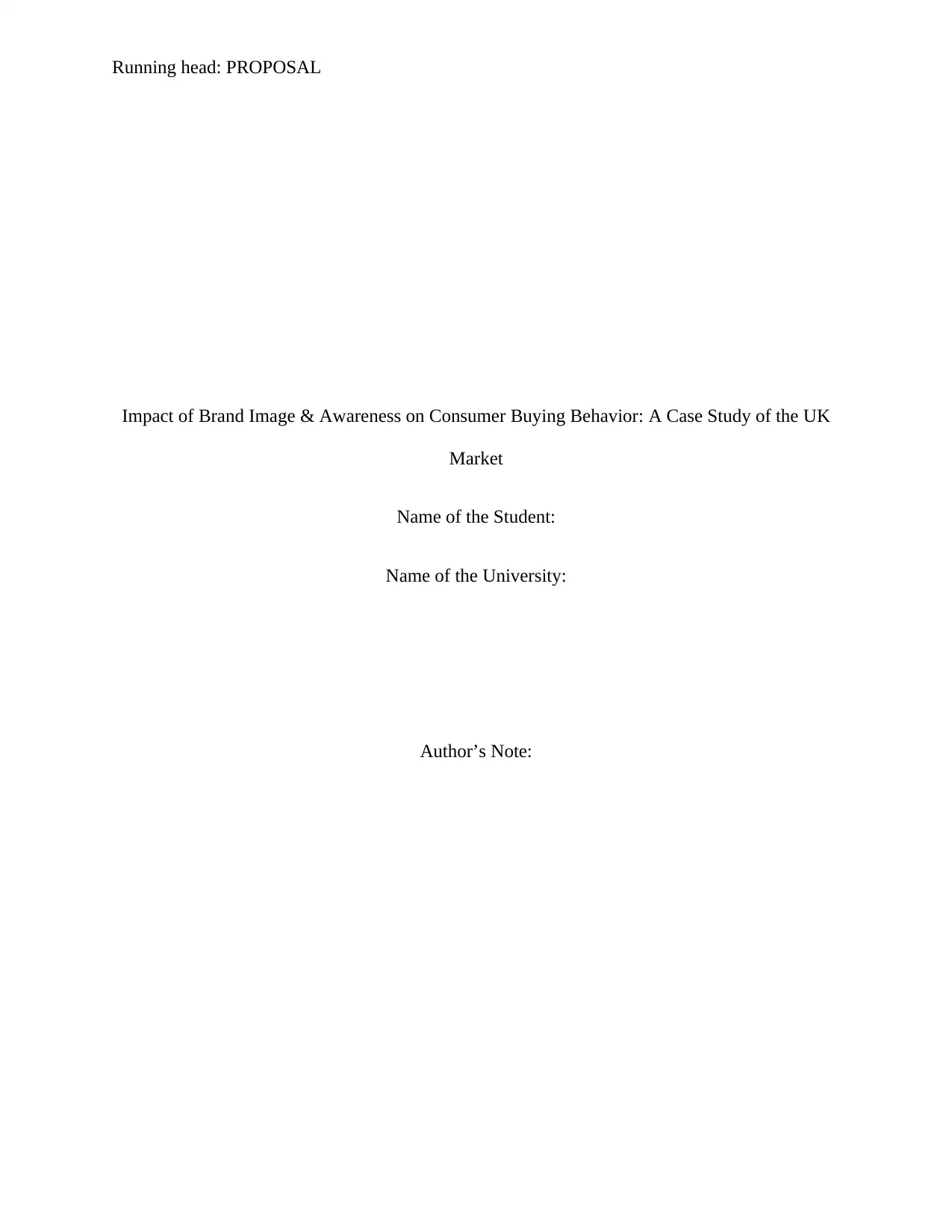
Running head: PROPOSAL
Impact of Brand Image & Awareness on Consumer Buying Behavior: A Case Study of the UK
Market
Name of the Student:
Name of the University:
Author’s Note:
Impact of Brand Image & Awareness on Consumer Buying Behavior: A Case Study of the UK
Market
Name of the Student:
Name of the University:
Author’s Note:
Paraphrase This Document
Need a fresh take? Get an instant paraphrase of this document with our AI Paraphraser
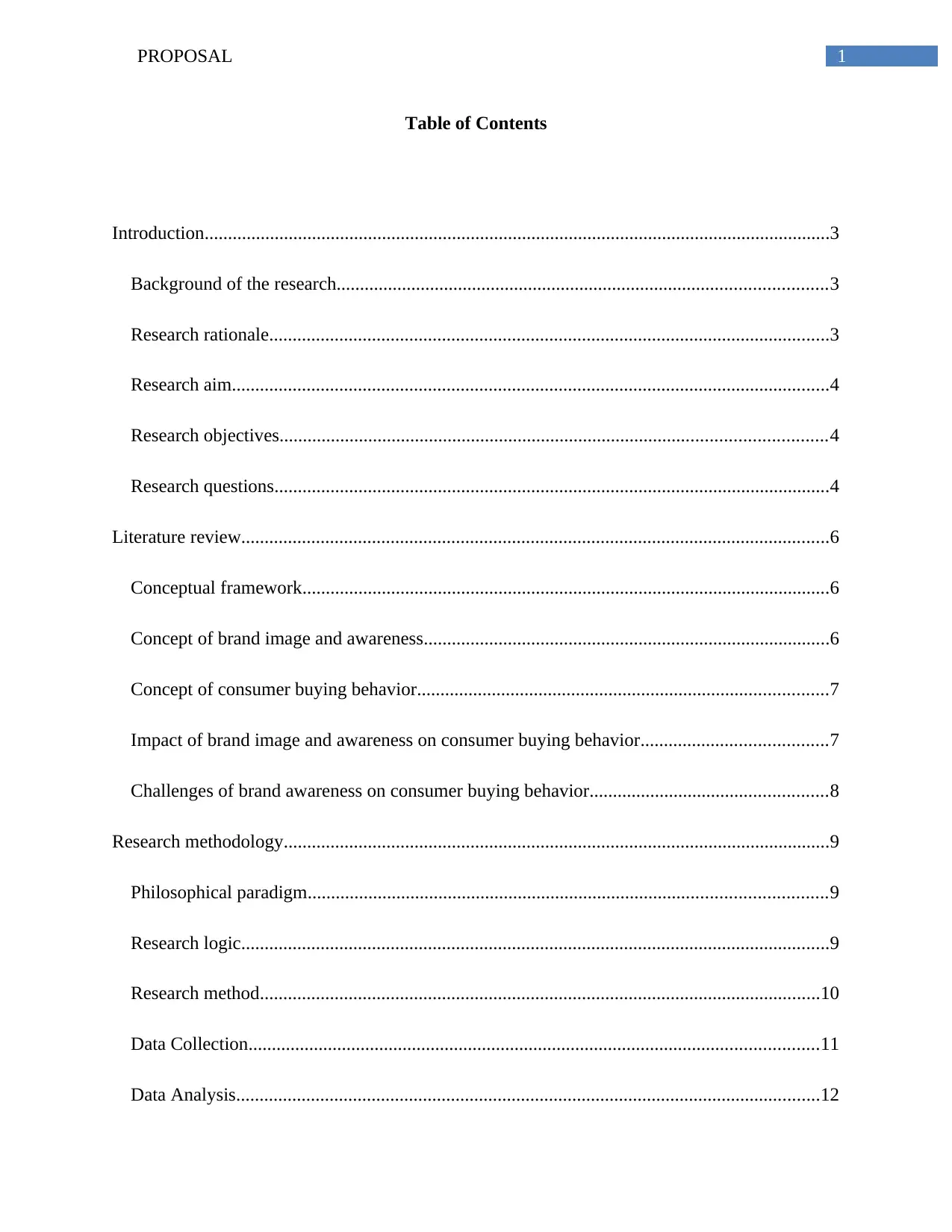
1PROPOSAL
Table of Contents
Introduction......................................................................................................................................3
Background of the research.........................................................................................................3
Research rationale........................................................................................................................3
Research aim................................................................................................................................4
Research objectives.....................................................................................................................4
Research questions.......................................................................................................................4
Literature review..............................................................................................................................6
Conceptual framework.................................................................................................................6
Concept of brand image and awareness.......................................................................................6
Concept of consumer buying behavior........................................................................................7
Impact of brand image and awareness on consumer buying behavior........................................7
Challenges of brand awareness on consumer buying behavior...................................................8
Research methodology.....................................................................................................................9
Philosophical paradigm...............................................................................................................9
Research logic..............................................................................................................................9
Research method........................................................................................................................10
Data Collection..........................................................................................................................11
Data Analysis.............................................................................................................................12
Table of Contents
Introduction......................................................................................................................................3
Background of the research.........................................................................................................3
Research rationale........................................................................................................................3
Research aim................................................................................................................................4
Research objectives.....................................................................................................................4
Research questions.......................................................................................................................4
Literature review..............................................................................................................................6
Conceptual framework.................................................................................................................6
Concept of brand image and awareness.......................................................................................6
Concept of consumer buying behavior........................................................................................7
Impact of brand image and awareness on consumer buying behavior........................................7
Challenges of brand awareness on consumer buying behavior...................................................8
Research methodology.....................................................................................................................9
Philosophical paradigm...............................................................................................................9
Research logic..............................................................................................................................9
Research method........................................................................................................................10
Data Collection..........................................................................................................................11
Data Analysis.............................................................................................................................12
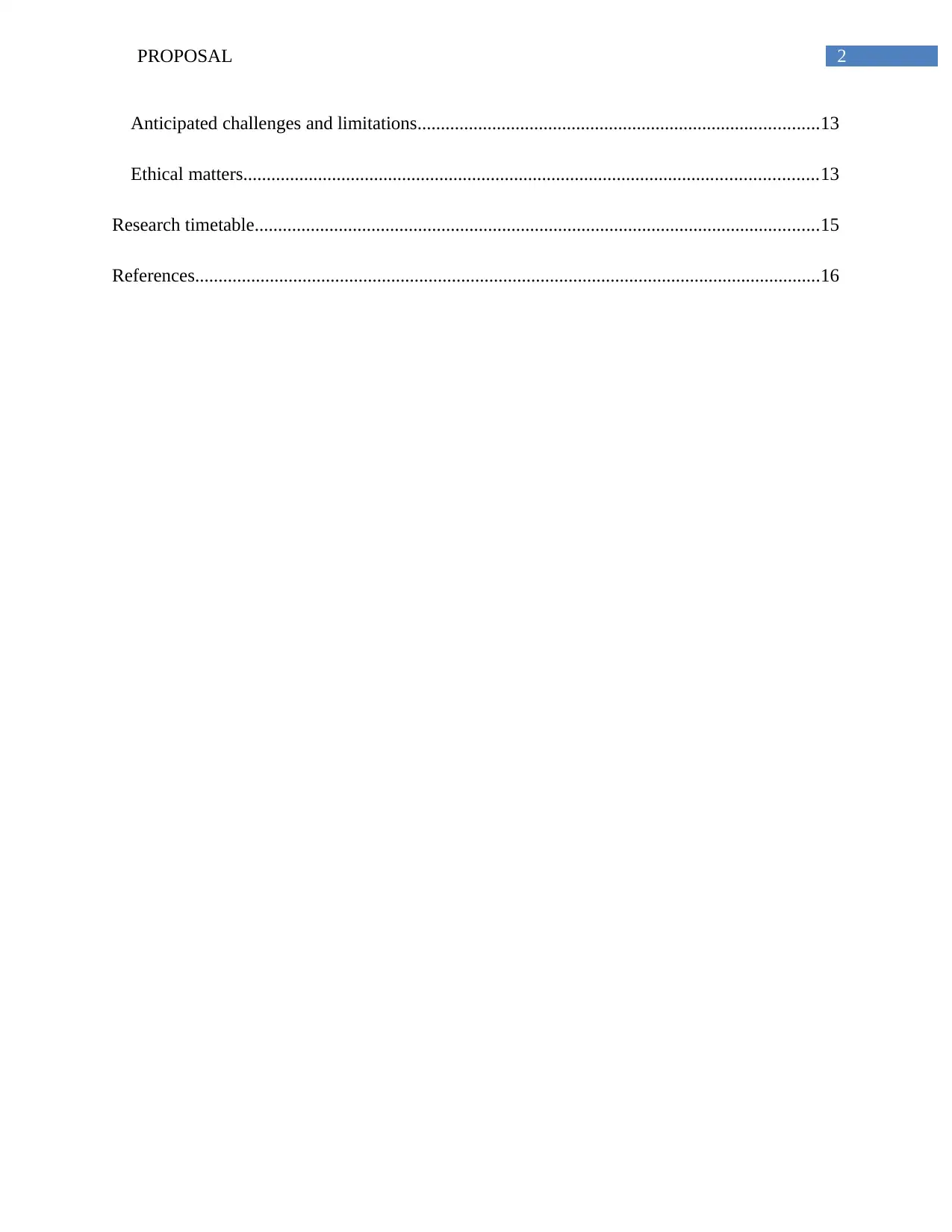
2PROPOSAL
Anticipated challenges and limitations......................................................................................13
Ethical matters...........................................................................................................................13
Research timetable.........................................................................................................................15
References......................................................................................................................................16
Anticipated challenges and limitations......................................................................................13
Ethical matters...........................................................................................................................13
Research timetable.........................................................................................................................15
References......................................................................................................................................16
⊘ This is a preview!⊘
Do you want full access?
Subscribe today to unlock all pages.

Trusted by 1+ million students worldwide
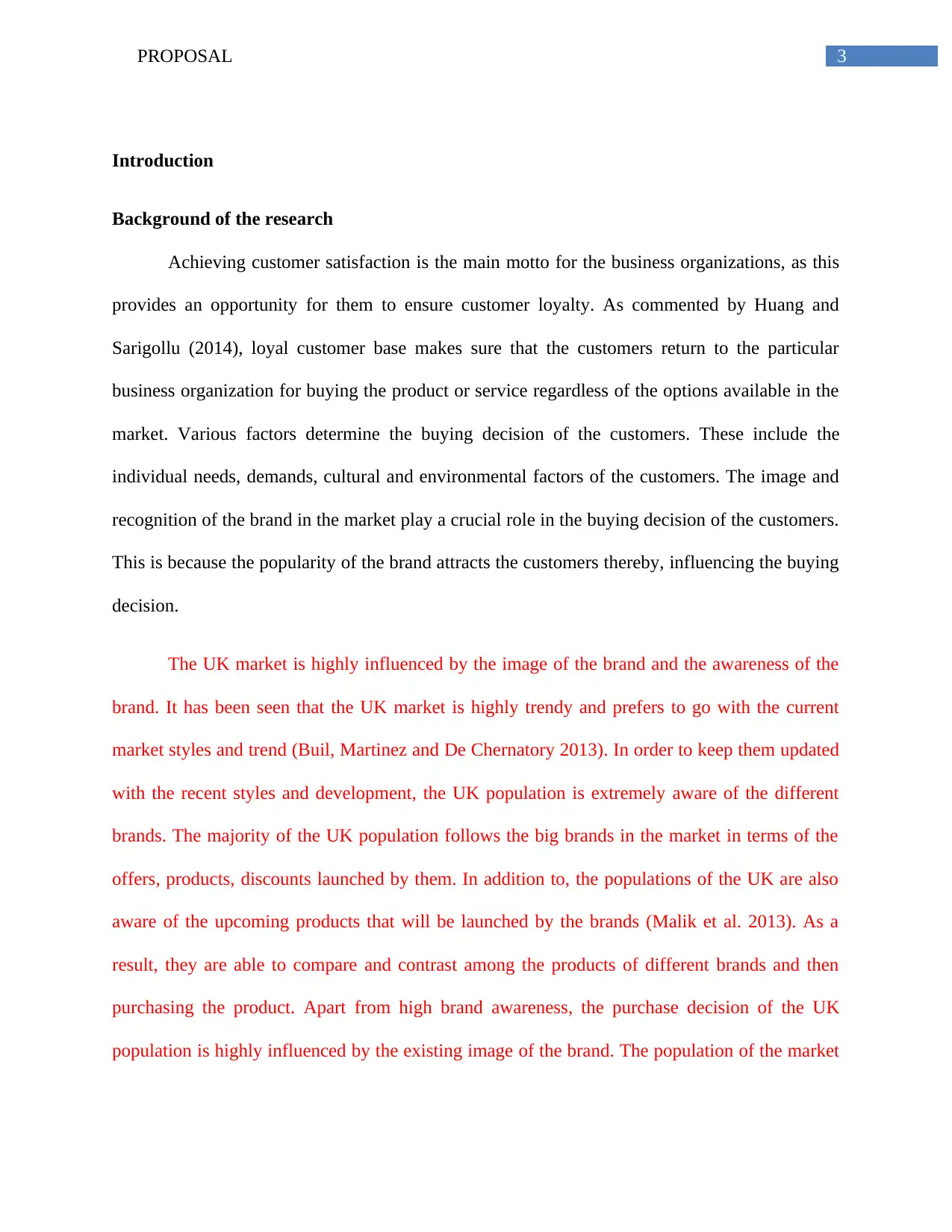
3PROPOSAL
Introduction
Background of the research
Achieving customer satisfaction is the main motto for the business organizations, as this
provides an opportunity for them to ensure customer loyalty. As commented by Huang and
Sarigollu (2014), loyal customer base makes sure that the customers return to the particular
business organization for buying the product or service regardless of the options available in the
market. Various factors determine the buying decision of the customers. These include the
individual needs, demands, cultural and environmental factors of the customers. The image and
recognition of the brand in the market play a crucial role in the buying decision of the customers.
This is because the popularity of the brand attracts the customers thereby, influencing the buying
decision.
The UK market is highly influenced by the image of the brand and the awareness of the
brand. It has been seen that the UK market is highly trendy and prefers to go with the current
market styles and trend (Buil, Martinez and De Chernatory 2013). In order to keep them updated
with the recent styles and development, the UK population is extremely aware of the different
brands. The majority of the UK population follows the big brands in the market in terms of the
offers, products, discounts launched by them. In addition to, the populations of the UK are also
aware of the upcoming products that will be launched by the brands (Malik et al. 2013). As a
result, they are able to compare and contrast among the products of different brands and then
purchasing the product. Apart from high brand awareness, the purchase decision of the UK
population is highly influenced by the existing image of the brand. The population of the market
Introduction
Background of the research
Achieving customer satisfaction is the main motto for the business organizations, as this
provides an opportunity for them to ensure customer loyalty. As commented by Huang and
Sarigollu (2014), loyal customer base makes sure that the customers return to the particular
business organization for buying the product or service regardless of the options available in the
market. Various factors determine the buying decision of the customers. These include the
individual needs, demands, cultural and environmental factors of the customers. The image and
recognition of the brand in the market play a crucial role in the buying decision of the customers.
This is because the popularity of the brand attracts the customers thereby, influencing the buying
decision.
The UK market is highly influenced by the image of the brand and the awareness of the
brand. It has been seen that the UK market is highly trendy and prefers to go with the current
market styles and trend (Buil, Martinez and De Chernatory 2013). In order to keep them updated
with the recent styles and development, the UK population is extremely aware of the different
brands. The majority of the UK population follows the big brands in the market in terms of the
offers, products, discounts launched by them. In addition to, the populations of the UK are also
aware of the upcoming products that will be launched by the brands (Malik et al. 2013). As a
result, they are able to compare and contrast among the products of different brands and then
purchasing the product. Apart from high brand awareness, the purchase decision of the UK
population is highly influenced by the existing image of the brand. The population of the market
Paraphrase This Document
Need a fresh take? Get an instant paraphrase of this document with our AI Paraphraser

4PROPOSAL
hardly considers additional factors such as cost, free shipping, discounts and gifts when it comes
to their preferred brand.
Research rationale
What is the issue?
Lack of appropriate brand image and brand awareness negatively affects the consumer
buying behavior or decision-making (Hutter et al. 2013).
Why is it an issue?
It is an issue because lack of loyal customer base hampers the profit and revenue of the
business organizations (Lu, Chang and Chang 2014).
Why is it an issue now?
It is an issue now because lack of brand image and brand awareness fails to influence the
consumer buying behavior of the customers due to which the business organizations tend to lose
competitive advantage and their survival is threatened in the market (Sasmita and Mohd Suki
2015).
What this research sheds light on?
The research sheds light on the importance of analyzing the impact of the brand image,
brand image, brand image and consumer buying decision, as this provides an opportunity for the
business organization to gain several benefits in terms of the customers and the market.
hardly considers additional factors such as cost, free shipping, discounts and gifts when it comes
to their preferred brand.
Research rationale
What is the issue?
Lack of appropriate brand image and brand awareness negatively affects the consumer
buying behavior or decision-making (Hutter et al. 2013).
Why is it an issue?
It is an issue because lack of loyal customer base hampers the profit and revenue of the
business organizations (Lu, Chang and Chang 2014).
Why is it an issue now?
It is an issue now because lack of brand image and brand awareness fails to influence the
consumer buying behavior of the customers due to which the business organizations tend to lose
competitive advantage and their survival is threatened in the market (Sasmita and Mohd Suki
2015).
What this research sheds light on?
The research sheds light on the importance of analyzing the impact of the brand image,
brand image, brand image and consumer buying decision, as this provides an opportunity for the
business organization to gain several benefits in terms of the customers and the market.

5PROPOSAL
Research aim
The aim of the research is to analyze the impact of brand image and awareness on
consumer buying behavior or decision-making.
Research objectives
The objectives of the research are:
To understand the concept of brand image, brand awareness and consumer buying
decision
To understand the concept of consumer buying behavior or decision-making
To evaluate critically the impact of the brand image, brand image and consumer buying
decision
To provide the suitable recommendation for improving brand image, brand image and
consumer buying decision
Research questions
The questions of the research are:
What do you mean by brand image, brand image and consumer buying decision?
What do you mean by consumer buying behavior or decision-making?
What is the impact of the brand image, brand image and consumer buying decision?
What are the suitable recommendations for improving brand image, brand image and
consumer buying decision
Research aim
The aim of the research is to analyze the impact of brand image and awareness on
consumer buying behavior or decision-making.
Research objectives
The objectives of the research are:
To understand the concept of brand image, brand awareness and consumer buying
decision
To understand the concept of consumer buying behavior or decision-making
To evaluate critically the impact of the brand image, brand image and consumer buying
decision
To provide the suitable recommendation for improving brand image, brand image and
consumer buying decision
Research questions
The questions of the research are:
What do you mean by brand image, brand image and consumer buying decision?
What do you mean by consumer buying behavior or decision-making?
What is the impact of the brand image, brand image and consumer buying decision?
What are the suitable recommendations for improving brand image, brand image and
consumer buying decision
⊘ This is a preview!⊘
Do you want full access?
Subscribe today to unlock all pages.

Trusted by 1+ million students worldwide

6PROPOSAL
Brand image
Brand awareness
Consumer perception Consumer buying behavior
Literature review
Conceptual framework
Figure 1: Conceptual framework
(Source: Created by Author)
Concept of brand image and awareness
In the competitive market, it is important for the customers to select from the variety of
products or brands that are available in the market. As commented by Severi and Ling (2013),
the image of the brand of the product influences the buying decision of the customers. This is
because the brand image is immensely popular, as the customers tend to develop emotions with
the brand with time. However, as argued by Malik et al. (2013), the concept of brand awareness
highly influences the brand equity and is defined as the familiarity of the customers with the
specific brand. Thus, brand awareness is the capacity of the customers in order to verify past
Brand image
Brand awareness
Consumer perception Consumer buying behavior
Literature review
Conceptual framework
Figure 1: Conceptual framework
(Source: Created by Author)
Concept of brand image and awareness
In the competitive market, it is important for the customers to select from the variety of
products or brands that are available in the market. As commented by Severi and Ling (2013),
the image of the brand of the product influences the buying decision of the customers. This is
because the brand image is immensely popular, as the customers tend to develop emotions with
the brand with time. However, as argued by Malik et al. (2013), the concept of brand awareness
highly influences the brand equity and is defined as the familiarity of the customers with the
specific brand. Thus, brand awareness is the capacity of the customers in order to verify past
Paraphrase This Document
Need a fresh take? Get an instant paraphrase of this document with our AI Paraphraser
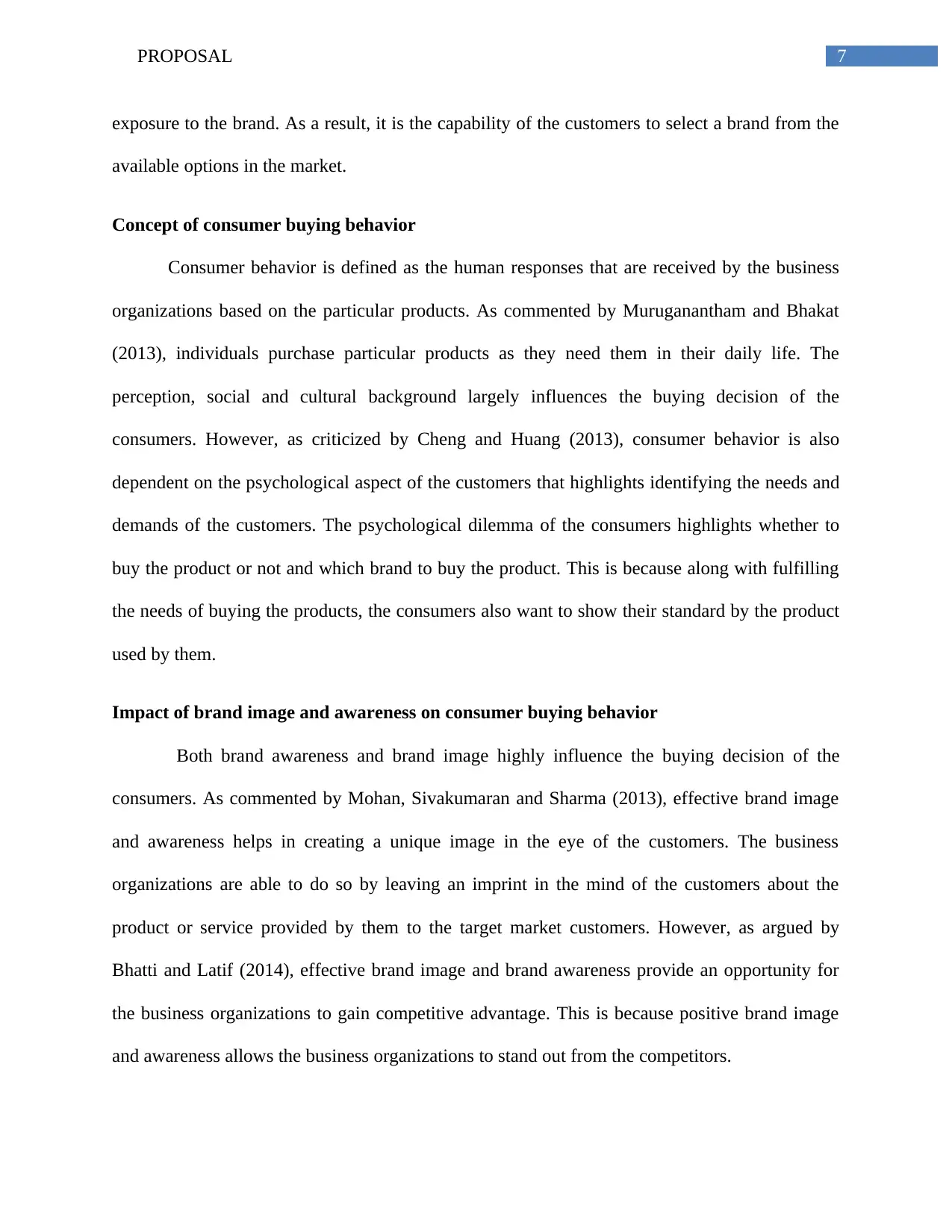
7PROPOSAL
exposure to the brand. As a result, it is the capability of the customers to select a brand from the
available options in the market.
Concept of consumer buying behavior
Consumer behavior is defined as the human responses that are received by the business
organizations based on the particular products. As commented by Muruganantham and Bhakat
(2013), individuals purchase particular products as they need them in their daily life. The
perception, social and cultural background largely influences the buying decision of the
consumers. However, as criticized by Cheng and Huang (2013), consumer behavior is also
dependent on the psychological aspect of the customers that highlights identifying the needs and
demands of the customers. The psychological dilemma of the consumers highlights whether to
buy the product or not and which brand to buy the product. This is because along with fulfilling
the needs of buying the products, the consumers also want to show their standard by the product
used by them.
Impact of brand image and awareness on consumer buying behavior
Both brand awareness and brand image highly influence the buying decision of the
consumers. As commented by Mohan, Sivakumaran and Sharma (2013), effective brand image
and awareness helps in creating a unique image in the eye of the customers. The business
organizations are able to do so by leaving an imprint in the mind of the customers about the
product or service provided by them to the target market customers. However, as argued by
Bhatti and Latif (2014), effective brand image and brand awareness provide an opportunity for
the business organizations to gain competitive advantage. This is because positive brand image
and awareness allows the business organizations to stand out from the competitors.
exposure to the brand. As a result, it is the capability of the customers to select a brand from the
available options in the market.
Concept of consumer buying behavior
Consumer behavior is defined as the human responses that are received by the business
organizations based on the particular products. As commented by Muruganantham and Bhakat
(2013), individuals purchase particular products as they need them in their daily life. The
perception, social and cultural background largely influences the buying decision of the
consumers. However, as criticized by Cheng and Huang (2013), consumer behavior is also
dependent on the psychological aspect of the customers that highlights identifying the needs and
demands of the customers. The psychological dilemma of the consumers highlights whether to
buy the product or not and which brand to buy the product. This is because along with fulfilling
the needs of buying the products, the consumers also want to show their standard by the product
used by them.
Impact of brand image and awareness on consumer buying behavior
Both brand awareness and brand image highly influence the buying decision of the
consumers. As commented by Mohan, Sivakumaran and Sharma (2013), effective brand image
and awareness helps in creating a unique image in the eye of the customers. The business
organizations are able to do so by leaving an imprint in the mind of the customers about the
product or service provided by them to the target market customers. However, as argued by
Bhatti and Latif (2014), effective brand image and brand awareness provide an opportunity for
the business organizations to gain competitive advantage. This is because positive brand image
and awareness allows the business organizations to stand out from the competitors.

8PROPOSAL
Challenges of brand awareness on consumer buying behavior
With the benefits of brand image and brand awareness, there come some potential
challenges of brand image and awareness on the buying decision of the consumers. As
commented by Bakshi and Gupta (2013), in certain instances the customers take an incorrect
decision of buying products. This is because the consumers blindly trust the brand and the
products or services provided by them to the target market. As a result, the business
organizations are provided with the opportunity of misleading or misguiding the consumers in
the name of their established brand.
Challenges of brand awareness on consumer buying behavior
With the benefits of brand image and brand awareness, there come some potential
challenges of brand image and awareness on the buying decision of the consumers. As
commented by Bakshi and Gupta (2013), in certain instances the customers take an incorrect
decision of buying products. This is because the consumers blindly trust the brand and the
products or services provided by them to the target market. As a result, the business
organizations are provided with the opportunity of misleading or misguiding the consumers in
the name of their established brand.
⊘ This is a preview!⊘
Do you want full access?
Subscribe today to unlock all pages.

Trusted by 1+ million students worldwide
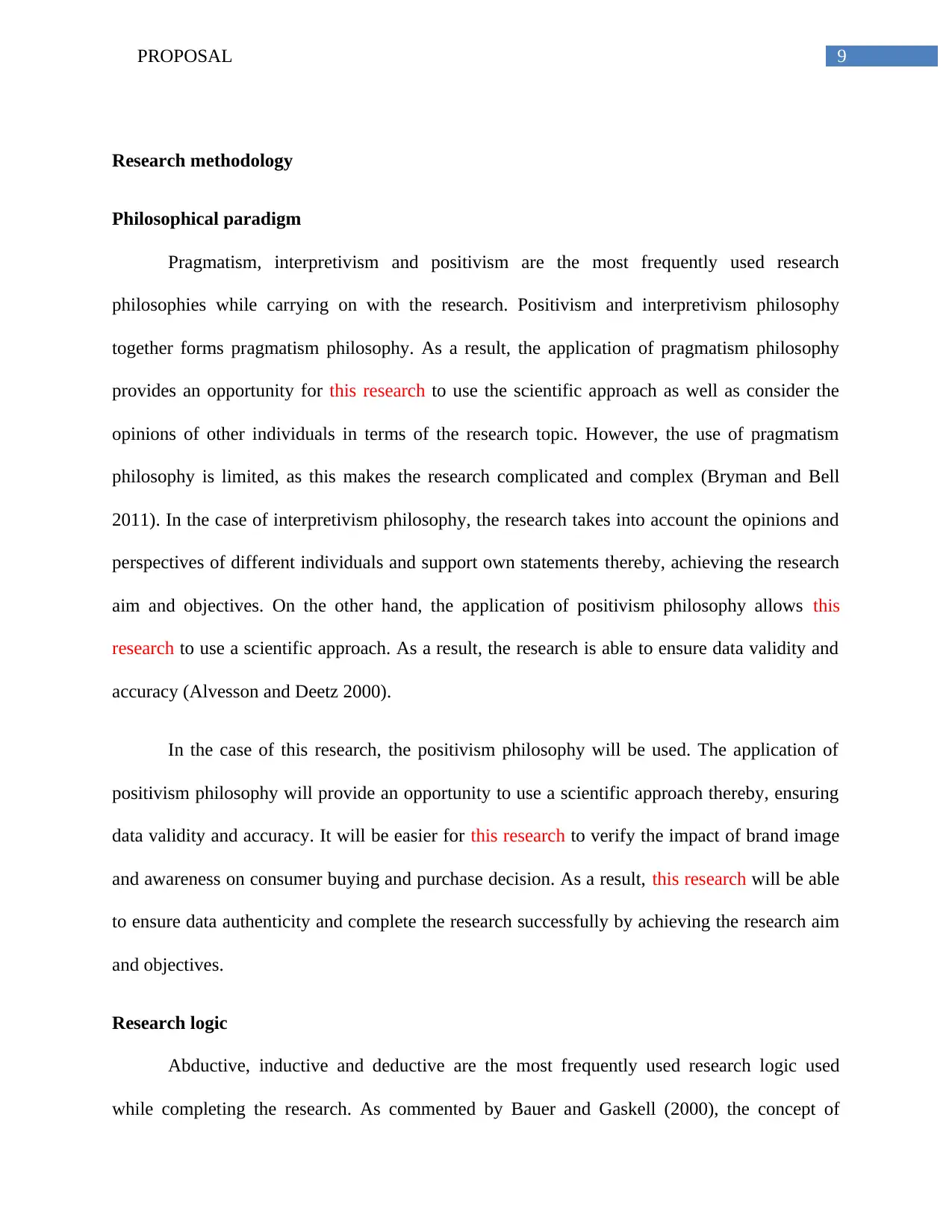
9PROPOSAL
Research methodology
Philosophical paradigm
Pragmatism, interpretivism and positivism are the most frequently used research
philosophies while carrying on with the research. Positivism and interpretivism philosophy
together forms pragmatism philosophy. As a result, the application of pragmatism philosophy
provides an opportunity for this research to use the scientific approach as well as consider the
opinions of other individuals in terms of the research topic. However, the use of pragmatism
philosophy is limited, as this makes the research complicated and complex (Bryman and Bell
2011). In the case of interpretivism philosophy, the research takes into account the opinions and
perspectives of different individuals and support own statements thereby, achieving the research
aim and objectives. On the other hand, the application of positivism philosophy allows this
research to use a scientific approach. As a result, the research is able to ensure data validity and
accuracy (Alvesson and Deetz 2000).
In the case of this research, the positivism philosophy will be used. The application of
positivism philosophy will provide an opportunity to use a scientific approach thereby, ensuring
data validity and accuracy. It will be easier for this research to verify the impact of brand image
and awareness on consumer buying and purchase decision. As a result, this research will be able
to ensure data authenticity and complete the research successfully by achieving the research aim
and objectives.
Research logic
Abductive, inductive and deductive are the most frequently used research logic used
while completing the research. As commented by Bauer and Gaskell (2000), the concept of
Research methodology
Philosophical paradigm
Pragmatism, interpretivism and positivism are the most frequently used research
philosophies while carrying on with the research. Positivism and interpretivism philosophy
together forms pragmatism philosophy. As a result, the application of pragmatism philosophy
provides an opportunity for this research to use the scientific approach as well as consider the
opinions of other individuals in terms of the research topic. However, the use of pragmatism
philosophy is limited, as this makes the research complicated and complex (Bryman and Bell
2011). In the case of interpretivism philosophy, the research takes into account the opinions and
perspectives of different individuals and support own statements thereby, achieving the research
aim and objectives. On the other hand, the application of positivism philosophy allows this
research to use a scientific approach. As a result, the research is able to ensure data validity and
accuracy (Alvesson and Deetz 2000).
In the case of this research, the positivism philosophy will be used. The application of
positivism philosophy will provide an opportunity to use a scientific approach thereby, ensuring
data validity and accuracy. It will be easier for this research to verify the impact of brand image
and awareness on consumer buying and purchase decision. As a result, this research will be able
to ensure data authenticity and complete the research successfully by achieving the research aim
and objectives.
Research logic
Abductive, inductive and deductive are the most frequently used research logic used
while completing the research. As commented by Bauer and Gaskell (2000), the concept of
Paraphrase This Document
Need a fresh take? Get an instant paraphrase of this document with our AI Paraphraser
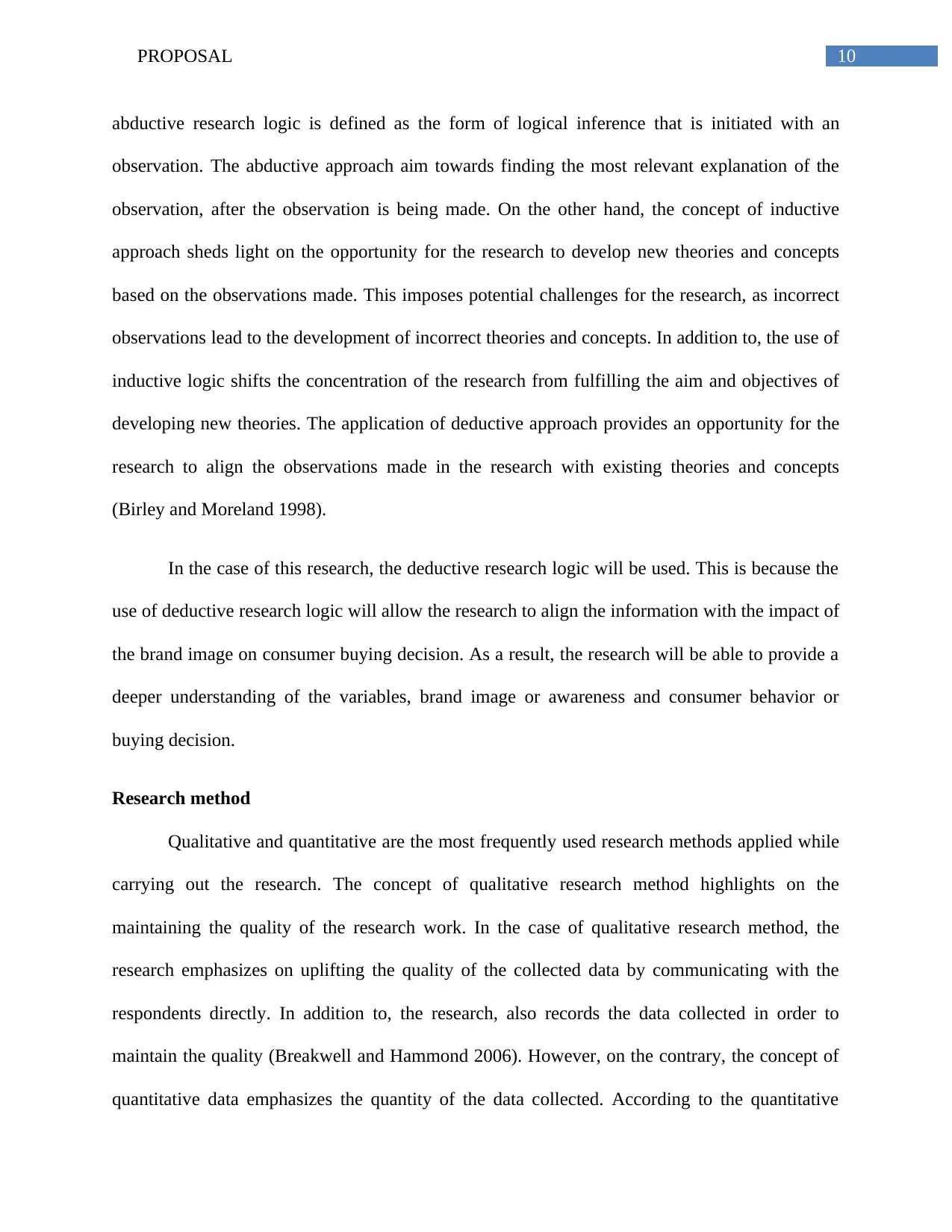
10PROPOSAL
abductive research logic is defined as the form of logical inference that is initiated with an
observation. The abductive approach aim towards finding the most relevant explanation of the
observation, after the observation is being made. On the other hand, the concept of inductive
approach sheds light on the opportunity for the research to develop new theories and concepts
based on the observations made. This imposes potential challenges for the research, as incorrect
observations lead to the development of incorrect theories and concepts. In addition to, the use of
inductive logic shifts the concentration of the research from fulfilling the aim and objectives of
developing new theories. The application of deductive approach provides an opportunity for the
research to align the observations made in the research with existing theories and concepts
(Birley and Moreland 1998).
In the case of this research, the deductive research logic will be used. This is because the
use of deductive research logic will allow the research to align the information with the impact of
the brand image on consumer buying decision. As a result, the research will be able to provide a
deeper understanding of the variables, brand image or awareness and consumer behavior or
buying decision.
Research method
Qualitative and quantitative are the most frequently used research methods applied while
carrying out the research. The concept of qualitative research method highlights on the
maintaining the quality of the research work. In the case of qualitative research method, the
research emphasizes on uplifting the quality of the collected data by communicating with the
respondents directly. In addition to, the research, also records the data collected in order to
maintain the quality (Breakwell and Hammond 2006). However, on the contrary, the concept of
quantitative data emphasizes the quantity of the data collected. According to the quantitative
abductive research logic is defined as the form of logical inference that is initiated with an
observation. The abductive approach aim towards finding the most relevant explanation of the
observation, after the observation is being made. On the other hand, the concept of inductive
approach sheds light on the opportunity for the research to develop new theories and concepts
based on the observations made. This imposes potential challenges for the research, as incorrect
observations lead to the development of incorrect theories and concepts. In addition to, the use of
inductive logic shifts the concentration of the research from fulfilling the aim and objectives of
developing new theories. The application of deductive approach provides an opportunity for the
research to align the observations made in the research with existing theories and concepts
(Birley and Moreland 1998).
In the case of this research, the deductive research logic will be used. This is because the
use of deductive research logic will allow the research to align the information with the impact of
the brand image on consumer buying decision. As a result, the research will be able to provide a
deeper understanding of the variables, brand image or awareness and consumer behavior or
buying decision.
Research method
Qualitative and quantitative are the most frequently used research methods applied while
carrying out the research. The concept of qualitative research method highlights on the
maintaining the quality of the research work. In the case of qualitative research method, the
research emphasizes on uplifting the quality of the collected data by communicating with the
respondents directly. In addition to, the research, also records the data collected in order to
maintain the quality (Breakwell and Hammond 2006). However, on the contrary, the concept of
quantitative data emphasizes the quantity of the data collected. According to the quantitative

11PROPOSAL
research method, the research focuses on the quantity or the numbers of the collected data. This
provides an opportunity for the research to ensure data validity and accuracy by considering the
numerical (Bryman and Cramer 1995).
In the case of this research, the research will be using quantitative research method. This
is because the use of quantitative research method is justified according to the selected research
philosophy and logic. In addition, the use of quantitative research method will allow the research
focus on the number of respondents and determine the impact of brand awareness or image on
consumer decision making or purchase decision.
Data Collection
The researches mostly use primary and secondary data collection methods. Secondary
data collection technique highlights the concept of gathering relevant data and information from
the secondary resources. The secondary resources include books, journals and other internet
facilities. The use of secondary resources allows the research to develop a deeper understanding
of the research topic (Creswell 2008). On the other hand, primary data collection method
highlights gathering recent and updated information and data from a particular population. The
use of primary data collection method provides an opportunity for the research to collect data
from the live participants and consider their viewpoints in terms of the research topic.
It is essential for the research to sample the participants for primary data collection
method. As the research has selected online survey, as the data collection method, it is important
for the research to use appropriate sampling technique. The best-suited sampling method for the
survey is random probability sampling technique. This is because random probability sampling
research method, the research focuses on the quantity or the numbers of the collected data. This
provides an opportunity for the research to ensure data validity and accuracy by considering the
numerical (Bryman and Cramer 1995).
In the case of this research, the research will be using quantitative research method. This
is because the use of quantitative research method is justified according to the selected research
philosophy and logic. In addition, the use of quantitative research method will allow the research
focus on the number of respondents and determine the impact of brand awareness or image on
consumer decision making or purchase decision.
Data Collection
The researches mostly use primary and secondary data collection methods. Secondary
data collection technique highlights the concept of gathering relevant data and information from
the secondary resources. The secondary resources include books, journals and other internet
facilities. The use of secondary resources allows the research to develop a deeper understanding
of the research topic (Creswell 2008). On the other hand, primary data collection method
highlights gathering recent and updated information and data from a particular population. The
use of primary data collection method provides an opportunity for the research to collect data
from the live participants and consider their viewpoints in terms of the research topic.
It is essential for the research to sample the participants for primary data collection
method. As the research has selected online survey, as the data collection method, it is important
for the research to use appropriate sampling technique. The best-suited sampling method for the
survey is random probability sampling technique. This is because random probability sampling
⊘ This is a preview!⊘
Do you want full access?
Subscribe today to unlock all pages.

Trusted by 1+ million students worldwide
1 out of 20
Related Documents
Your All-in-One AI-Powered Toolkit for Academic Success.
+13062052269
info@desklib.com
Available 24*7 on WhatsApp / Email
![[object Object]](/_next/static/media/star-bottom.7253800d.svg)
Unlock your academic potential
Copyright © 2020–2025 A2Z Services. All Rights Reserved. Developed and managed by ZUCOL.





